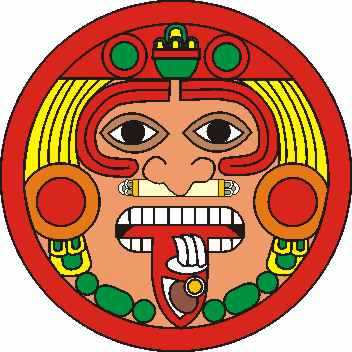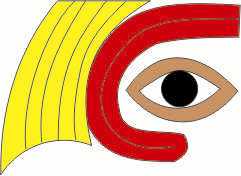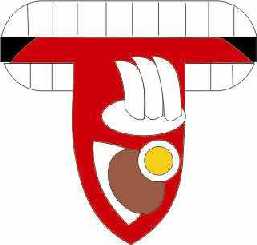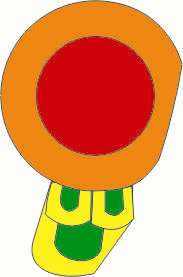- Index
- Dedication
- Authors
- Introduction
1 - Tonatiuh
2 - Cosmogonic Epochs
- The Five Suns
- The Jaguar Sun
- The Sun of Wind
- The Sun of the Rain of Fire
- The Sun of Water
- The Sun of the Earthqueakes
- The Four Cardinal Points
3 - Tonalli
Days
01 | 02 | 03 | 04 | 05
06 | 07 | 08 | 09 | 10
11 | 12 | 13 | 14 | 15
16 | 17 | 18 | 19 | 20
4 - Solar Rays
5 - The Serpentine Binary
6 - The Edge of the Stone
7- Aztec Cosmogony
- Official Details
- How the Aztecs measured Time
- The Aztecs Months
- Glossary
- Bibliography
- Images
- Back Cover
- Book in Word Format
- Book in PDF Format
Chapter 1. Tonatiuh, the God of the Sun
Tonatiuh – the Luminous One Who Warms.
“Tonatiuh, the Verb of San Juan, the Logos or creator of the universe, with its triangular tongue of fire, is the golden child of sexual alchemy, the spiritual sun at midnight, the eagle that rises and soars, the resplendent dragon of wisdom, and it is represented by the star that gives us life, light and heat. Decorated by the Nahualts, it appears in glory at the very center of the Stone of the Sun”.
Samael Aun Weor – The Secret Doctrine of Anahuac.

In each and every corner of the world, mankind has strived to give tangible representations to personify the great realities of the spirit. It should not amaze us that the Incas, Mayas, Aztecs, Egyptians, etc. resembled the sun with the universal spirit of life in an attempt to relate its physical and spiritual characteristics. In this way, they taught others about the greatness of that which is intangible. Undoubtedly the sun has been, is, and will be the means to allow the world to understand what truly is the Spirit of the Being within each one of us. Just like the physical sun imparts life, light and warmth, our Being gives us spiritual life, wisdom and wishes to learn that which is mystical.
Among the Aztecs, the God of the Sun was called Tonatiuh (Tona = the maker of the sun and heat, tiuth = to go). In universal Gnosticism, is it the Being or the Spirit the one who imparts life, and at the same time, the sun is the symbol each aspirant should manifest within: to create the sun is to integrate oneself with the Being.
The God of the Sun, Tonatiuh, is represented in the microcosm by the Intimate, the most spiritual element within each man and woman. In the macrocosm he is the Solar Logos or the Divinity. Either one will trigger our impulse towards the self-realization of our Being, using as its means awakening that is both mystical and spiritual.
In Nahuan culture, as in others, the Sun was the symbol of the Father, the eternal Masculine Principle; the Moon, the mother or the eternal Divine Feminine Principle, and Venus, the symbol of the Celestial Child. Tonatiuh, the God of the Sun, is the incarnation and expression of the fire that comes from the heavens. Tonatiuh is the representation of the divine aspects and itself explains the creation of all that exists.
The wise Aztecs of Anahuac gave the creator both: masculine and feminine form. The creator in its masculine aspect was called Ometecuhtli (ome = two, tecuhtli = Lord), and the divine feminine principle Omecihuatl (ome = two, cihuatl = Lady). They are the Lord and the Lady, God and Goddess of Duality. On this aspect, VM Samael Aun Weor states:
“The face of Tonatiuh in the Aztec calendar is the face of Ometecuhtli-Omecihatl, Lord and Lady of duality, God of life, of love and generation.”
“Enclosed by two concentric circles, around which are four squares within two other concentric circles (the unmanifested absolute: Ipalnemohuani), encompass it all: the feline claws of Quetzalcoatl ripping human hearts, the Sun of Wind or 4 Ehecatl, the Sun of Fire or 4 Quiahuitl, the Sun of Water or 4 Atl, the Sun of Jaguar or 4 Ocelot and the Sun of Movement or 4 Olin, the East and the West, the North and the South, the twenty days of the month, etc.”
“This explains why the Nahuans venerated the Sun and the dual significance the numbers had for them.”
Samael Aun Weor – Aztec Christic Magic, Monogram No. 8

Tonatuih’s crown or Xiuhitzolli represents the Ancient of Days, the Kaballistic Kether, the three aspects of divinity: the Father, Son and Holy Spirit, the Logoic triangle of the Hebrews.
Each man has its own particular ray, resplendent in all its glory and might in the world of the ineffable Gods; the golden ray, the Being of our Being, the internal Christ of each man. It is the Sephirotic crown of the cabbalists, the Crown of Life. “Be faithful till thy death (says the Holy One), and I shall give thee the Crown of Life”. (Revelations 2:10).
We will find all the attributes of divinity wisely expressed in their artistic forms by the wise of Anahuac, as we can tell from the date of Two Canes in its crown. The number 2 (both circles) represent the feminine and masculine aspects of divinity.
“Ometecuhtli-Omecihuatl, Lord and Lady of duality. “Ome”: two; “Tecuhtli”: Lord. “Ome”: two; “Cihuatl”: Lady. From this divine dual principle, masculine and feminine, emanated the Universe. This God-Goddess had four sons, the four Tezcatlipocas: Xipotec, the red one; Tezcatlipoca, the black one; Quetzalcoatl, the white one; Hizilopochtli, the blue one.”
“From this divine and indivisible binary were born the four colors of the four races that populate the Earth. Ometecuhtli has the presence of the Cosmis Christ. The Nahuas represented him with a beautifully adorned tunic and a stone phallus, symbol of light. Omecihuatl has all the presence of the Cosmic Virgin.”
“The Nahuas represented her with a beautiful blue mantle…”
“He is Huehueteotl, the Ancient God, father of the gods and father of men. She is Tonantzín, our beloved Mother.”
Samael Aun Weor – Aztec Christic Magic, Monograph No. 10
The three eagle feathers of the symbol of the cane, or Acatl, together with the pearl, represent the Greek TETRAGRAMMATON, the holy FOUR, symbol of the Trinity plus that which is unmanifested.

In ancient times the hair was directly related to the creative energies, similar to what we have seen in the myth of Sampson and Delilah on the Hebrew kabala.
The wrinkles around his eyes allegorize the wisdom we should reach by awakening our consciousness in our daily living. Among the Aztecs, the maximum authority was represented by a council of elders, who had dedicated their lives to the elimination of their egocentric interests.
The eyes of the God of the Sun are the eyes of the Internal Father, who sees all, who is always vigilant to that which we think, do and feel.

In the nose or Yacaxihuitl we find a wise combination between the breath that imparts life and the work with the masculine and feminine forces, as we see three eagle feathers on each side. The number 6 (3 feathers on each side) represents the crossing of these forces.
The Borgia Codex mentions the ritual of the perforation of the nose. This ritual is intimately related to the science of sexual transmutation through breaths, breathing and respiration.
The Solar Logos emanates all its creative might to this world and then collects it transmuted, to impart himself life. In a similar manner, the human being should imitate this process.

The tongue in shape of a blade or Tecpatl, is the verb, the word, the Logos, the power the verb has manifested in all that has been created. Curiously, we find in the tongue an eye, symbol of psychological self-observation, showing the necessity of being attentive to what we say, as the verb carries extensive responsibility. In addition, we find a claw that shows the power of the word. With the word we can bless or damn, aid or cause suffering. This shows us the sacrifice the initiate must undergo to ensure the right use of the word. The word has the power to create, which is why it is necessary to develop self-observation as well as a sense of responsibility in its use. We need to learn when to speak and when to be silent.
“In the beginning it was the Word, and the Word was with God and the Word was God. This was in the beginning with God. All things by Him were created, and without Him none of what is would be. In Him was life, and life was the Light of men.”
St. John, 1:1-4, Bible of Casiodoro de Reyna, 1569.

In the Chalchihuitl (precious stones) we see six jades forming Tonatiuh’s collar. These symbolize the virtues of the soul: tenacity, patience, willpower, altruism, philanthropy, love… all acquired through the destruction of the undesirable psychological aggregates we carry within.
In his ears or Xiuhnacochtli we see that from the shape of the circle emanates an adornment of three eagle feathers. The circle is a symbol of eternity, the unknown absolute, that which the Greek referred to as Agnostos Theos (the unknowable God which cannot be defined). In Sanscrit it is known as Sat (That). From that which has no name emanates the trinity of the Father, the Son and the Holy Spirit, and as a result, the Holy Four: the Tetragrammaton.

The ears show by themselves the need to listen to that which is spiritual, to closing our ears to blasphemy, damnation, prejudices and all unsubstantial words of the ego, but to place our attention in the Voice of the Silence, the Wisdom of our Father.
“Ears with large pendants show the need to learn to listen, to place our attention to wisdom.”
Samael Aun Weor – Mayan Mysteries
